spécifications du produit
Condition:
 More Info
More Info
Condition

Well Loved - A well loved boot shows significant signs of wear and tear including heel wear, scratching, and scuffing on a majority of the boot’s surface area.
Fair - A fair boot shows some signs of wear and tear on the sole of the boot. This includes chipping, scratching and scuffing on high impact areas like the heel and toe lugs. The liners in these boots are typically very broken in.
Good - A good boot shows minor signs of wear and tear with little heel and toe wear, some minor cosmetic scratches across both boots, but no major damage. Liners in these boots have been broken in but still have some life left in them.
Excellent - An excellent boot shows almost no signs of wear and tear on the sole or upper of the boot shell. The liners in these boots show little signs of break in and will fit tighter than a boot that has been used more.
Terrain:
Backcountry More Info
More Info
terrain

Groomers - Though it is rare a boot is designed for one sole terrain type, boots that are categorized for groomers are generally designed for more beginner to intermediate skiers. Boots in this category are generally a soft to medium flex with the exception of race ski boots which are generally stiffer.

All Mountain - Most boots are classified as All Mountain. This category covers the widest range of volume, flex and performance. These boots are made to ski various types of terrain and surfaces.

Freestyle - Freestyle boots are generally made to be light and nimble when performing tricks. This style of boot usually has a medium flex.

Big Mountain/Powder - Boots for big mountain/powder skiing are stiffer in nature and provide a higher performance fit. Stiffness creates the support you need when skiing at high speeds or through rough, variable terrain.

Backcountry - Backcountry boots are built for skiing as well as touring uphill. They are built with lighter constructions and offer closure systems that are meant to reduce weight compared to an alpine ski boot. These boots generally feature a walk mode which allows the boot to flex backwards, creating a more natural stride pattern when skinning uphill. A majority of backcountry boots also feature tech inserts in the toe and heel of the boot to accommodate a pin style binding.
Ability Level:
Intermediate-Expert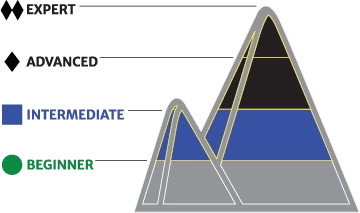 More Info
More Info
Ability Level

Beginner - Skis, Boards, Boots and Bindings for the beginner skier or boarder are built to be more forgiving and easier to handle on the slopes. Skis and Boards are typically built with foam or wood cores that are more flexible and have shorter radii, making them less challenging to turn. Bindings are generally more pliable than models built for more advanced skiers or boarders.
Intermediate - Skis, Boards, Boots and Bindings for intermediate skiers or boarders generally provide more stability and performance than beginner focused equipment. Skis and Boards generally have medium radiuses with better handling at higher speed while still being forgiving at slower speeds.
Advanced - Skis, Boards, Boots and Bindings for advanced skiers or boarders generally provide a stiffer, higher performance ride that is better suited for steeper terrain and higher speeds. Skis and Boards generally have medium to large radii. Bindings are generally more rigid and provide better power transfer.
Expert - Skis, Boards, Boots and Bindings for expert skiers or boarders are built to provide the highest level of precision and power. Skis and Boards are generally on the stiffer side requiring more effort and technique to turn effectively.
Last:
96Last

The last of a ski boot is essentially the width measurement of the boot shell at the forefoot. The last is also a general indication of the volume inside the boot shell; a wider last increases the boot’s overall volume. A boot with a narrow last is generally measured at 97mm or 98mm wide. A medium last measurement is about 99mm - 101mm, and a wide last is any measurement 102mm or greater.
Moldable Liner:
Yes More Info
More Info
Moldable Liner
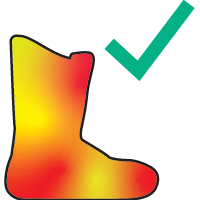
In recent years, many manufacturers have started building liners that can be custom molded to the skier’s foot using a specialized oven. The liner is heated to soften the inner foam and inserted into the boot shell. The skier then inserts their foot, tightens the buckles and stands in the boots while the liners cool and form to their feet. A heat moldable liner allows for greater fit customization for the skier and ultimately more comfort.
**The liner molding process should always be performed by a qualified boot-fitter with the proper tools. Trying this at home could damage your liners. **
Sole Type:
 More Info
More Info
Sole Type

Alpine ISO 5355 - The most common sole type for inbounds skiing, the Alpine ISO 5355 norm is the traditional flat sole style with hard plastic where the boot contacts the binding. Boots with an Alpine ISO 5355 sole are compatible with Alpine, MNC, WTR and GripWalk certified bindings.
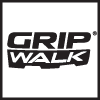
GripWalk - GripWalk has become an industry standard sole type over recent years and is often found in alpine specific boots and some hybrid inbound/touring boots containing tech toe and heel fittings. Originally introduced to provide a more natural walking feeling, GripWalk soles feature a more rockered profile. GripWalk boots are compatible with GripWalk certified bindings along with MNC, WTR and touring bindings (provided the boot has tech fittings).

Touring ISO 9523 - The Touring ISO 9523 sole type has tech fittings in both the toe and heel of the boot and a rockered rubber sole for more natural walking. Some Touring ISO 9523 boot soles feature an anti friction device plate that aids in release, but others do not. Boots in this category are compatible with ISO Certified touring bindings and MNC bindings.

Non ISO-Certified - Non ISO-Certified touring boots are built outside the standard norm for Touring ISO 9523, but are compatible with the universal tech (pin) bindings. These boots are only compatible with bindings certified for non compliant touring boots.
Liner Type:
Tongue More Info
More Info
Liner Type

Tongue - The tongue style liner is the classic liner construction found in most ski boots. Tongue liners are often thinner than wrap style liners but offer a better fit for those with a higher instep.
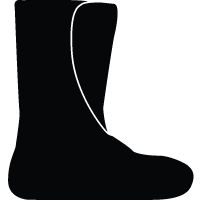
Wrap - Wrap liners are less common than tongue liners and are often found in a 3 piece style boot like the Dalbello Krypton/Lupo line or any Full Tilt boot. Wrap liners generally take up more volume in the boot shell, and are better suited for skiers with skinnier legs/calves.
Tech Toe Compatible:
YesTech Toe Compatible

Modern touring bindings have been engineered to attach differently than a traditional alpine binding. The “Tech” style binding uses pins that fit into specific inserts in the sides of the boot’s toe and into the back of the boot’s heel. These special inserts are built into the boot and are necessary to utilize a tech style touring binding.
Walk Mode:
Yes More Info
More Info
Walk Mode
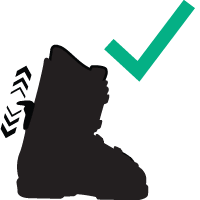
Walk modes are generally found on all touring boots and some inbounds alpine boots. Walk mode can be advantageous to both a resort skier looking for comfort and a backcountry skier looking for increased range of motion and efficiency when skinning uphill. A walk mode device allows the user to free the cuff of the boot to flex both forward and backward, allowing for a more natural stride.
Replaceable Soles:
No More Info
More Info
Replaceable Soles
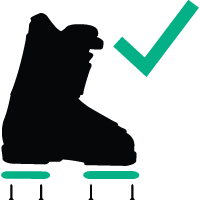
Some boots feature replaceable soles in the form of plastic plates that screw on and off the sole of the boot. Replaceable soles prolong the life of the boots once they’ve experienced lots of wear from walking on non-snow surfaces.
2022 Atomic Backland Ultimate AT Boots
The Atomic Backland Ultimate is designed for uphill athletes looking for endurance and speed. With a narrow 96mm last and small cuff, these boots are Atomic's premium option for bagging peaks. Brand new!
spécifications du produit
Condition:
 More Info
More Info
Condition

Well Loved - A well loved boot shows significant signs of wear and tear including heel wear, scratching, and scuffing on a majority of the boot’s surface area.
Fair - A fair boot shows some signs of wear and tear on the sole of the boot. This includes chipping, scratching and scuffing on high impact areas like the heel and toe lugs. The liners in these boots are typically very broken in.
Good - A good boot shows minor signs of wear and tear with little heel and toe wear, some minor cosmetic scratches across both boots, but no major damage. Liners in these boots have been broken in but still have some life left in them.
Excellent - An excellent boot shows almost no signs of wear and tear on the sole or upper of the boot shell. The liners in these boots show little signs of break in and will fit tighter than a boot that has been used more.
Terrain:
Backcountry More Info
More Info
terrain

Groomers - Though it is rare a boot is designed for one sole terrain type, boots that are categorized for groomers are generally designed for more beginner to intermediate skiers. Boots in this category are generally a soft to medium flex with the exception of race ski boots which are generally stiffer.

All Mountain - Most boots are classified as All Mountain. This category covers the widest range of volume, flex and performance. These boots are made to ski various types of terrain and surfaces.

Freestyle - Freestyle boots are generally made to be light and nimble when performing tricks. This style of boot usually has a medium flex.

Big Mountain/Powder - Boots for big mountain/powder skiing are stiffer in nature and provide a higher performance fit. Stiffness creates the support you need when skiing at high speeds or through rough, variable terrain.

Backcountry - Backcountry boots are built for skiing as well as touring uphill. They are built with lighter constructions and offer closure systems that are meant to reduce weight compared to an alpine ski boot. These boots generally feature a walk mode which allows the boot to flex backwards, creating a more natural stride pattern when skinning uphill. A majority of backcountry boots also feature tech inserts in the toe and heel of the boot to accommodate a pin style binding.
Ability Level:
Intermediate-Expert More Info
More Info
Ability Level

Beginner - Skis, Boards, Boots and Bindings for the beginner skier or boarder are built to be more forgiving and easier to handle on the slopes. Skis and Boards are typically built with foam or wood cores that are more flexible and have shorter radii, making them less challenging to turn. Bindings are generally more pliable than models built for more advanced skiers or boarders.
Intermediate - Skis, Boards, Boots and Bindings for intermediate skiers or boarders generally provide more stability and performance than beginner focused equipment. Skis and Boards generally have medium radiuses with better handling at higher speed while still being forgiving at slower speeds.
Advanced - Skis, Boards, Boots and Bindings for advanced skiers or boarders generally provide a stiffer, higher performance ride that is better suited for steeper terrain and higher speeds. Skis and Boards generally have medium to large radii. Bindings are generally more rigid and provide better power transfer.
Expert - Skis, Boards, Boots and Bindings for expert skiers or boarders are built to provide the highest level of precision and power. Skis and Boards are generally on the stiffer side requiring more effort and technique to turn effectively.
Last:
96Last

The last of a ski boot is essentially the width measurement of the boot shell at the forefoot. The last is also a general indication of the volume inside the boot shell; a wider last increases the boot’s overall volume. A boot with a narrow last is generally measured at 97mm or 98mm wide. A medium last measurement is about 99mm - 101mm, and a wide last is any measurement 102mm or greater.
Moldable Liner:
Yes More Info
More Info
Moldable Liner

In recent years, many manufacturers have started building liners that can be custom molded to the skier’s foot using a specialized oven. The liner is heated to soften the inner foam and inserted into the boot shell. The skier then inserts their foot, tightens the buckles and stands in the boots while the liners cool and form to their feet. A heat moldable liner allows for greater fit customization for the skier and ultimately more comfort.
**The liner molding process should always be performed by a qualified boot-fitter with the proper tools. Trying this at home could damage your liners. **
Sole Type:
 More Info
More Info
Sole Type

Alpine ISO 5355 - The most common sole type for inbounds skiing, the Alpine ISO 5355 norm is the traditional flat sole style with hard plastic where the boot contacts the binding. Boots with an Alpine ISO 5355 sole are compatible with Alpine, MNC, WTR and GripWalk certified bindings.

GripWalk - GripWalk has become an industry standard sole type over recent years and is often found in alpine specific boots and some hybrid inbound/touring boots containing tech toe and heel fittings. Originally introduced to provide a more natural walking feeling, GripWalk soles feature a more rockered profile. GripWalk boots are compatible with GripWalk certified bindings along with MNC, WTR and touring bindings (provided the boot has tech fittings).

Touring ISO 9523 - The Touring ISO 9523 sole type has tech fittings in both the toe and heel of the boot and a rockered rubber sole for more natural walking. Some Touring ISO 9523 boot soles feature an anti friction device plate that aids in release, but others do not. Boots in this category are compatible with ISO Certified touring bindings and MNC bindings.

Non ISO-Certified - Non ISO-Certified touring boots are built outside the standard norm for Touring ISO 9523, but are compatible with the universal tech (pin) bindings. These boots are only compatible with bindings certified for non compliant touring boots.
Liner Type:
Tongue More Info
More Info
Liner Type

Tongue - The tongue style liner is the classic liner construction found in most ski boots. Tongue liners are often thinner than wrap style liners but offer a better fit for those with a higher instep.

Wrap - Wrap liners are less common than tongue liners and are often found in a 3 piece style boot like the Dalbello Krypton/Lupo line or any Full Tilt boot. Wrap liners generally take up more volume in the boot shell, and are better suited for skiers with skinnier legs/calves.
Tech Toe Compatible:
YesTech Toe Compatible

Modern touring bindings have been engineered to attach differently than a traditional alpine binding. The “Tech” style binding uses pins that fit into specific inserts in the sides of the boot’s toe and into the back of the boot’s heel. These special inserts are built into the boot and are necessary to utilize a tech style touring binding.
Walk Mode:
Yes More Info
More Info
Walk Mode

Walk modes are generally found on all touring boots and some inbounds alpine boots. Walk mode can be advantageous to both a resort skier looking for comfort and a backcountry skier looking for increased range of motion and efficiency when skinning uphill. A walk mode device allows the user to free the cuff of the boot to flex both forward and backward, allowing for a more natural stride.
Replaceable Soles:
No More Info
More Info
Replaceable Soles

Some boots feature replaceable soles in the form of plastic plates that screw on and off the sole of the boot. Replaceable soles prolong the life of the boots once they’ve experienced lots of wear from walking on non-snow surfaces.


